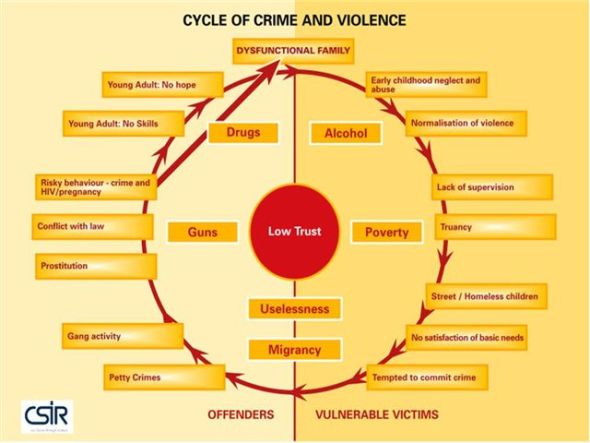On software projects, we often speak about the cost of change, and the way in which we try to keep this cost as low as possible. We recognise that traditional models have led to an ever-increasing cost of change. That is, the later in the project’s life-cycle that we identify a defect, the more expensive it will be to fix it. And in agile software projects, we work very hard to ensure that this cost is kept low, as we know that our resources are limited. One of the ways we do this, is by identifying problems early, and addressing them as soon as possible, to limit the extent to which they can develop. Not rocket surgery.
I was invited to attend a workshop this last weekend, hosted by Barbara Holtmann of the CSIR (Council for Industrial and Scientific Research) Crime Prevention Centre. Barbara has developed a model for understanding the factors contributing to the cycle of crime and violence in our communities. She complements that with a model demonstrating the necessary conditions for a safe community (which we will address in a later post).
 |
Barbara made the point that this cycle is perpetuated by the continued ignoring of all those who are in the ‘Vulnerable Victims’ phase of the cycle, and the continued dedication of incredibly costly resources to those in the ‘Offenders’ phase of the cycle.
Of course, effecting change so far down the line is going to be costly, because the problem is so much more severe after such extensive exposure to the negative elements. And can we afford not to intervene when the ‘Offenders’ are a threat to their communities? But, had the intervention been initiated earlier in the cycle, the later (expensive) interventions would not be necessary.
It would seem that, if this was my project, I would want to apply more resources to the ‘Vulnerable Victims’. I would want to institute early warning systems. Detect potential problems, and (instead of ignoring or isolating), apply even more resources to solve the problems while they are still manageable.
If this was a business problem, what else would we need to consider? How else can we extend the metaphor? How else could we apply our finite resources to build safe communities?
You must log in to post a comment.